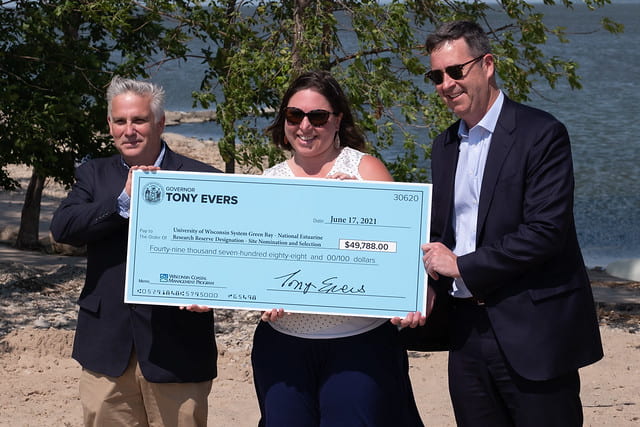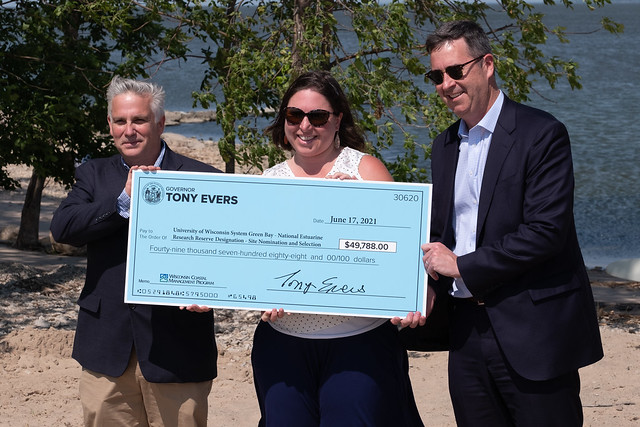Wisconsin Secretary of Administration Joel Brennen traveled to Green Bay on Thursday, June 17 at 3 p.m. to present a grant of $49,788, supporting the region’s efforts to locate a National Estuarine Research Reserve (NERR) on the Bay of Green Bay. In partnership with local and national agencies, UW-Green Bay is leading efforts to recognize local waters as a national reserve—an important next step in the region’s 30-plus-year effort to protect one of the largest surface freshwater systems on earth.
The NERR designation will help UW-Green Bay and its partners bring in funding—more than $1 million per year—for water-focused scientific research, education, stewardship and training, and will include a visitor center for hands-on and place-based education, lab space, conference area, and a boat launch. The event took place at South Bay Marina, Green Bay.

Secretary Brennen, Chip McDonald (president of McDonald Companies); and UW-Green Bay’s Director of Freshwater Strategy Emily Tyner were the speakers at the event.
The event served to highlight the state of Wisconsin’s ongoing support for this significant opportunity to research, preserve and protect one of the world’s greatest water resources and encourage local communities to actively participate in the location selection process.
McDonald described why his is impassioned about the project:
“When I was in sixth grade I was a pretty poor student. I was blessed to have a few teachers that took a big chance on me and the rest of my friends. One teacher—Çhuck Bretl—happens to be here today
Those educators realized they had an uphill battle. So they designed STEM before STEM. They designed and built a science curriculum around building a canoe, out of donated milk cartons. Then the final exam in sixth grade was sailing our canoe across the UWGB pool. Yes, that’s right…. 100 grade schoolers in the GB pool. The experience was amazing, and it sparked a life long desire for knowledge.
That changed my life.
They launched a carrier where I was able to help design aircraft carriers, work on submarines and most importantly live my dream by giving back to help our environment and youth.
By helping with GBSP who has been able to get over 2000 kids out and access the greatest fresh water estuary in the world the experience is simply magical.
The greatest investment we can make is in education of our youth and the protection of the world we live in.
Today I would like to personally thank UWGB, Dean Dornbush, our legislators and representatives from the State of Wisconsin and all the great educators that inspire.
They have been diligently working for years to bring the NEER to the shores of Green Bay. This investment of time and effort will help future generations of children, students, researchers experience from North Eastern Wisconsin bring dreams to reality.”
In the photo from left to right: Mike Friis, program manager for the Wisconsin Coastal Management Program and member of our NERR steering committee, Tyner and Brennen.
Click to advance slideshow or view the album on Flickr.
– Photos by Dan Moore, Marketing and University Communication.
About the Wisconsin Coastal Management Program
The Department of Administration’s Wisconsin Coastal Management Program (WCMP) is dedicated to preserving and improving access to the natural and historic resources of Wisconsin’s Great Lakes coasts. Since 1978, the program has worked cooperatively with federal, state, tribal, and local government agencies and non-profit organizations to manage the ecological, economic, and aesthetic assets of the Great Lakes coastal areas.
About the National Estuarine Research Reserve on Green Bay
Upon site selection within the Green Bay estuary, the NERR designation (National Estuarine Research Reserve) will use locally relevant and nationally significant research to address local coastal management issues and help protect the world’s largest freshwater estuary. The goal of the Green Bay National Estuarine Research Reserve is to be the most technologically-advanced NERR in a network of 29 reserves covering more than 1.3 million acres throughout the U.S. The reserve would be non-regulatory, state-owned and managed entity, with program guidance and technical assistance from NOAA.



